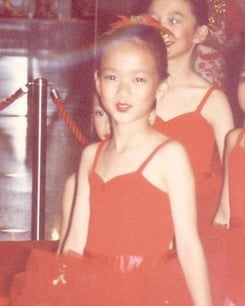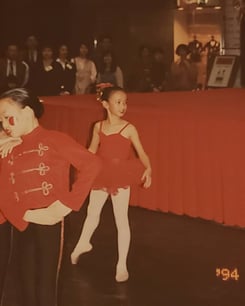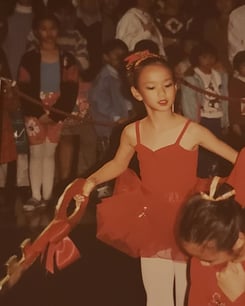My Dance Education
What's in a dance education?
6/22/20248 min read
At age four, my parents enrolled me in a summer dance program to teach me grace, poise, etiquette, and discipline. Growing up, I was very much a tomboy. My mushroom bowl cut didn't help either. My parents noticed my musical talent and inability to sit still, so they thought dance might be a good creative outlet. It was a ballet class, and I absolutely hated it because the teacher made me do the splits. After that summer program, my parents had me try out other activities.
It wasn't until I was seven, when all my friends were taking ballet, that I begged my mom to let me return to ballet. She agreed on the condition that I wouldn't quit after a few lessons. I agreed, and we know where that took me.
As a late-starter, I knew I had a lot to catch up on. Though I had the talent, I lacked the right facility: flat feet, bow-legged, and inflexible. But one thing I knew was that I LOVED ballet. It was the storytelling, the ability to explore, the music that felt relatable, and the structure within the art form that drew me in. As much as I was enamored by the pink outfits and tutus, it was the music and movement that captivated me.
I worked on my feet every day, stretching them and doing foot exercises. I stretched for flexibility whenever I could: while watching TV, before bed, and the moment I woke up. The level of obsession to catch up was unreal. The next hurdle was mastering the Royal Academy of Dance grade syllabus. I still remember parents recording syllabus music with their tape recorders so students could practice at home. I practiced religiously. I was that kid who took notes and knew the steps inside out. With the help of my teachers, I took all my grade exams before moving back to the States. I studied exam videos, visually learning the steps. My dad dubbed full-length ballets onto VHS tapes, which I watched on repeat: The Royal Ballet, the Bolshoi Ballet, New York City Ballet, and more. Yes, all at the young age of 7-15.
Through my determination and hard work, I overcame most of my shortcomings. This lesson taught me that with hard work, one can overcome obstacles. Because I didn't have the perfect body for ballet (including timing), it forced me to find a way through it all. It also taught me that learning doesn't just come from written tests but also from observation and audible skills that help develop coordination, perception, and motor skills.
While pursuing my passion for dance, I was heavily bullied at school. Everyone saw my love for a classical art as "uncool." The cool thing at that time was to hang out with the boys, play basketball, or be on the "dance team." Funny enough, some of those bullies have since enrolled their own daughters in ballet classes. Ballet became a way for me to cope with the excessive bullying. I felt seen and heard in an art form that allowed me to express my true self. I was happiest in the studio, learning, rehearsing, and performing. It felt like home.
When I returned to the States for high school, I enrolled in two different studios. This was where the struggle really began. In a completely different country, navigating cultural shock, and being around different studio environments was tough. Again, ballet was a way for me to cope with the inevitable changes. It was always there for me, offering space to be vulnerable and express myself through movement.
I completed my Royal Academy of Dance vocational exams except for Solo Seal. I didn't see the point of completing exams that didn't lead to a dance contract or professional opportunities. I completed the levels to have a tangible record to show that I’m “legit.” I couldn't stand teachers with no professional dance experience but all the professional theory, teaching an art form that requires extensive understanding of anatomy. I always tell my students, “turn out” is a verb. “To turn out” because it requires muscles and alignment. It didn't help that my teachers encouraged competition, eating disorders, and toxic behavior. This topic deserves its own post.
Casting and favoritism were based on body type rather than talent. I believe you can nurture any body type if you embody the art of teaching dance and communicate it effectively to another individual. That’s an amazing teacher.
I was introduced to dance competitions as a way to be valued and favored at one of the studios. I joined the ballet competition team in my junior year of high school, where I had a solo and was cast in small and large ensembles. I enjoyed rehearsing in the studio. Overcoming the challenges of the works made me feel unstoppable. I continued exploring characterization, musicality, and refining my artistry. I remember watching DVDs (yes, we graduated to DVDs) of principal dancers from ballet companies performing classical variations. This was also when I encountered Lines Ballet, my first experience with contemporary ballet.
However, the competitions themselves made me sick to my stomach. The immense pressure to do well debilitated my ability to perform. The stakes were high. The anxiety of justifying all the hours of driving my mom did, the money invested in classes, privates, and opportunities in the two minutes of my solo, was overwhelming. It was no longer the joy I felt performing; it was a sport with winners and rankings based on technical requirements, costumes, and a judge’s preference or mood. Looking back as a professional, although it was an opportunity to develop skills in confidence through dedication, resilience, and focus, I am always reluctant about dance competitions.
Failures and rejections at competitions are very real. Some competitions offer scholarships through their audition classes. Failure and rejection felt like a direct reflection of my talent. I equated it to being a bad dancer. Handling failure requires self-awareness, acceptance, patience, and compassion—qualities hard for any kid or teenager. I'm grateful it was a time when social media wasn't mainstream. Kids could grieve and accept in private. Till this day, I remind myself that failure does not reflect one’s ability or worth. Rejection is redirection (or protection). It is an essential skill to master, as it requires developing mental capacity to handle in strides.
The jealousy among peers and their moms was disheartening. I couldn't understand why dance moms would treat me with contempt simply because I placed higher than their daughter. The passive-aggressive remarks and non-verbal cues were upsetting. I witnessed sabotage of costumes and props at the studio and competitions. The adults didn't address the issue; in fact, it was encouraged. This forced me to develop thick skin at a young age.
There are advantages to attending competitions. As a choreographer and coach, I use them as a measure of progress, to develop skills and resilience to accomplish a project with a hard deadline. The presentation is a test of mental focus under the most distracting environment. My dad always said, “you are comparing apples to oranges.” And I would always answer, “I LIKE ORANGES MORE” which proved his point. Competitions are the same. If there’s one thing I would tell my younger self, it would be that although the outcome determines favoritism from your teacher, it does not reflect your talent. You were just not someone’s cup of tea due to many other factors.
Summer intensives were a love-hate experience for me. As a hypersensitive introverted kid, acclimating to new environments and constantly being around groups of people was hard. Attending intensives at American Ballet Theater, The Kirov Academy, and The Juilliard School taught me independence, trying new things, and overcoming social anxiety. In environments with extremely talented dancers, you either feel inferior or make yourself available to observe and learn. I did a bit of both as a teen but now lean heavily toward the latter. I understood this holds true anywhere in life. There will always be someone more talented, intelligent, strategic, focused, prettier, taller, etc. It is a matter of how you approach the situation and turn it into a learning opportunity.
Attending college was compulsory for me, and I chose to attend the University of California Irvine, where I earned my BFA in Dance Performance and BA in Economics in four years. I knew I wanted to dance professionally at some point, but I was glad to have four years to figure it out. I started out in modern level 2 (the lowest for a major) and ballet level 3 (out of 5). Going in as only classically-trained, 8am modern three days a week was one of the hardest experiences. I learned the most basic skills in modern, including weight-shifting, grounding, falling, and spatial awareness. This was my start to understanding dance beyond ballet. On top of dance technique classes, we were also required to take music for dancers, choreography, injury prevention, Laban dance notation theory, kinesiology, and dance history. The dance academic classes changed my perception of dance and how it relates to the tapestry of cultures. I started experiencing the world through my knowledge of dance as an art form and its history. What stuck with me was studying how ballets like “The Nutcracker” are racist, with the ballet created from the perspective of the western world as depicted in Act 2. Attending my liberal arts academic classes also helped bring the dance academic classes full circle. My time as a double major was not easy, prioritizing performing in almost all the shows each year as a dance major while fulfilling my requirements as an Economics major. If it was not for the skill of time management I developed as a teenager juggling academics at a public school and dancing at two studios (exams and competitions), I would not have graduated magna cum laude.
I gradually made my way up the levels of modern and ballet, finishing both genres in level 5. Performing in almost all the shows in the dance program, the process resembled a professional dance company. We were required to learn everyone’s parts, dance in corps/ensemble roles, and take on soloist and principal roles. There would be days when I had to fill in for someone who was absent. These were the most critical moments, reflecting whether you could step up to the challenge, which could lead to an actual performance opportunity.
By my third year, I was accepted into the late Donald McKayle’s “Etude Ensemble,” which was one of the most valuable experiences as an aspiring dancer. He was a walking piece of history. Not only was he an American modern dance legend, but he was also an amazing human being. Through him, I learned the importance of being human even in leadership—to always have fun and never take life too seriously. He lived each day of his life with song, dance, humanity, and kindness. He made dance accessible to dancers of all backgrounds and training, with the only requirement being that we were ready to be vulnerable. All these qualities he incorporated into his works. To this day, my body still remembers what it is like to dance his works—one of the most empowering feelings.
During my last quarter as a fourth year, I auditioned for two companies in Chicago. Upon graduation, I moved to Chicago and started dancing professionally with Thodos Dance Chicago. Eventually, I moved temporarily to Europe to freelance before returning to the Bay Area to dance for Dance Theatre of San Francisco, Oakland Ballet Company, and KAMBARA+.
Throughout my career, I’ve traveled abroad for auditions and workshops. I explore a new city or country through dance and art. Whether it be taking classes, attending a performance, or visiting museums, it brings me joy to know that even with language and cultural barriers, these new places are accessible to me through an art form I resonate with. I love meeting new people who share the same passion and love for dance. The world feels a bit more connected during a time of disconnection.
Since this post focuses on my dance education, we will save the professional career stories for another time. But to wrap up, investing in a child’s dance education is more than certificates, trophies, social media posts, and bragging rights. You are investing in their physical, mental, emotional, and social development as an accountable asset to society. Children are placed into scenarios in which they acquire skills to overcome challenges or problem-solve in real life. In an age of technology, we forget humans are social beings that require face-to-face interactions. Self-discovery, exploration, creativity, perseverence and critical thinking are essential skills to cultivate as adults. Dance happens to be the medium through which your child learns these skills.
Learning a classical art form provides depth, enriching a person’s character in multifaceted ways. Classical arts like ballet demand a deep understanding of tradition, discipline, and history, fostering respect for the past. Culturally, it offer a window into the human experience, broadening perspectives and fostering appreciation for diverse cultures and histories. Overall, the depth gained from learning a classical art form shapes individuals into well-rounded, empathetic, and intellectually curious people. It’s about cultivating a richer, more nuanced understanding of oneself and the world. In a world dominated by instant gratification and technology, where connectivity can ironically lead to disconnection, the arts serve as our sanctuary. Investing in classical arts is investing in lifelong personal and artistic growth.
S.






Baby Sharon circa 1994, 2 years into ballet (Hong Kong)
